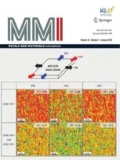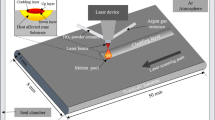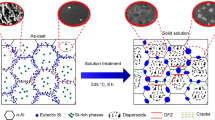Abstract
Five W-alloy specimens, containing 8.57% Ni, 6.34% Cu, and 1.34% Mo, were bombarded with 5.2 MeV singly charged nitrogen ions. The ions dose range was 5 × 1014–1 × 1016 ions/cm2. XRD patterns portrayed diffraction peaks of pure W as well as of Cu0.4W0.6, MoNi4, and Ni4W phases. Harris analysis showed that the preferentially oriented planes depend on the nitrogen ions dose. The structural parameters, namely lattice strain and crystallite size, vary with nitrogen ions dose alike. Same pattern is followed by surface hardness and electrical resistivity. The increase in the values of all the parameters with ions dose is rapid in the range 0–1 × 1015 ions/cm2 and later on slow till the maximum ions dose 1 × 1016 ions/cm2. However, the interdependence of each parameter on the other ones was linear. Surface roughness of the specimens was found to decrease on increasing ions dose. On the other hand, surface hardness registers a rise as crystallite size increases, and hence follows Inverse Hall–Petch relation.
Graphic Abstract














Similar content being viewed by others
References
K. Yabe, O. Nishimura, T. Fujihana, M. Iwaki, Characterization of the surface layer of various metals implanted with nitrogen. Surf. Coat. Technol. 66, 250–254 (1994)
H.L. Zhang, D.Z. Wang, N.K. Huang, The effect of nitrogen ion implantation on tungsten surfaces. Appl. Surf. Sci. 150, 34–38 (1999)
H. Savaloni, F. Modiri, Surface nano-structural modifications and characteristics in nitrogen ion implanted W as a function of temperature and N+ energy. Appl. Surf. Sci. 253, 1135–1142 (2006)
M.F. Arani, H. Savaloni, M. Ghoranneviss, Dependence of surface nano-structural modifications of Ti implanted by N+ ions on temperature. Appl. Surf. Sci. 256, 4502–4511 (2010)
M. Manouchehrian, M.M. Larijani, B. Banagar, Influence of energy nitrogen ion implantation on structural and mechanical properties of chromium thin film. J. Thin Films Sci. Technol. 3, 67–70 (2014)
S. Intarasiri, L.D. Yu, T. Chudoba, H. Reuther, U. Rammelt, E. Richter, Hardness, tribological behavior and corrosion performance at the very near surface of nitrogen ion-implanted X5CrNi18.10 steel. Surf. Coat. Technol. 99, 305–310 (1998)
A.A. Youssef, P. Budzynski, J. Filiks, A.P. Kobzev, J. Sielanko, Improvement of wear and hardness of steel by nitrogen implantation. Vacuum 77, 37–45 (2004)
A. Belbah, A. Mkaddem, N. Ladaci, N. Mebarki, M.E. Mansori, Low energy implantation to inhibit wear in N+ ions implanted WC–Co composite. Mater. Des. 53, 202–208 (2014)
J.F. Ziegler, M.D. Ziegler, J.P. Biersack, SRIM—The stopping and range of ions in matter. Nucl. Inst. Methods Phys. Res. B Beam Interact. Mater. Atom. 268, 1818–1823 (2010)
SRIM-2013. www.srim.org/SRIM/SRIMLEGL.htm
M.Z. Butt, D. Ali, M. Aftab, F. Bashir, M.L. Khalid, M.W. Khaliq, Role of carbon ions implantation in modifying the structural, electrical, and mechanical properties of W–8.57 Ni–6.34 Cu–1.34 Mo alloy. Phys. B Condens. Matter 573, 49–61 (2019)
M. Rafique, M.Z. Butt, S. Ahmad, Investigation of morphological, structural, and mechanical characteristics of Zircaloy-4 irradiated with 3.5 MeV hydrogen ions beam. Mater. Res. Exp. 4, 096507 (2017)
J.D. Makinson, J.S. Lee, S.H. Magner, R.J.D. Angelis, W.N. Weins, A.S. Hieronymus, X-ray diffraction signatures of defects in nanocrystalline materials. Adv. X-ray Anal. 42, 407–411 (2000)
T. Ungar, Characterization of nanocrystalline materials by X-ray line profile analysis. J. Mater. Sci. 42, 1584–1593 (2007)
B.D. Cullity, Elements of X-Ray Diffraction, 3rd edn. (Addison-Wesley Publishing Company, Inc., Massachusetts, 1956), pp. 272–274
G.B. Harris, X. Quantitative measurement of preferred orientation in rolled uranium bars. Philos. Mag. 424, 113–123 (1952)
G.K. Williamson, W.H. Hall, X-ray line broadening from filed aluminum and wolfram. Acta Metall. 1, 22–31 (1953)
Y. Rosenberg, V.S. Machavariani, A. Voronel, S. Garber, A. Rubshtein, A.I. Frenkel, E.A. Stern, Strain energy density in the X-ray powder diffraction from mixed crystals and alloys. J. Phys. Condens. Matter 12, 8081–8088 (2000)
B. Jiang, G.J. Weng, A composite model for the grain-size dependence of yield stress of nanograined materials. Metal. Mater. Trans. A 34, 765–772 (2003)
A.H. Chokshi, A. Rosen, J. Karch, H. Gleiter, On the validity of the Hall–Petch relationship in nanocrystalline materials. Scr. Metall. 23, 1679–1683 (1989)
R.A. Masumura, P.M. Hazzledine, C.S. Pande, Yield stress of fine grained materials. Acta Mater. 46, 4527–4534 (1998)
H. Conrad, J. Narayan, On the grain size softening in nanocrystalline materials. Scr. Mater. 42, 1025–1030 (2000)
S. Takeuchi, The mechanism of the inverse Hall–Petch relation of nanocrystals. Scr. Mater. 44, 1483–1487 (2001)
C.E. Carlton, P.J. Ferreira, What is behind the inverse Hall–Petch effect in nanocrystalline materials? Acta Mater. 55, 3749–3756 (2007)
M. Dao, L. Lu, R.J. Asaro, J.T.M.D. Hosson, E. Ma, Toward a quantitative understanding of mechanical behavior of nanocrystalline metals. Acta Mater. 55, 4041–4065 (2007)
H. Conrad, Grain-size dependence of the flow stress of Cu from millimeters to nanometers. Metall. Mater. Trans. A 35, 2681–2695 (2004)
J. Schiøtz, K.W. Jacobsen, A maximum in the strength of nanocrystalline copper. Science 301, 1357–1359 (2003)
M.Z. Butt, A.M. Majeed, M.W. Khaliq, D. Ali, Structural, electrical, and mechanical characterization of Al 5086 alloy irradiated with 248 nm–20 ns KrF excimer laser. J. Alloys Compd. 695, 3069–3082 (2017)
A. Sergeev, V. Mitin, Electron-phonon interaction in disordered conductors: Static and vibrating scattering potentials. Phys. Rev. B 61, 6041–6047 (2000)
H. Kaya, U. Böyük, E. Çadırlı, N. Maraşlı, Measurements of the microhardness, electrical and thermal properties of the Al–Ni eutectic alloy. Mater. Des. 34, 707–712 (2012)
H. Kaya, U. Böyük, E. Çadırlı, N. Maraşlı, Influence of growth rate on microstructure, microhardness, and electrical resistivity of directionally solidified Al-7 wt% Ni hypo-eutectic alloy. Met. Mater. Int. 19, 39–44 (2013)
E. Çadırlı, Effect of solidification parameters on mechanical properties of directionally solidified Al-Rich Al–Cu alloys. Met. Mater. Int. 19, 411–422 (2013)
E. Cadirli, M. Sahin, Influence of temperature gradient and growth rate on the mechanical properties of directionally solidified Sn–3.5 wt% Ag eutectic solder. J. Mater. Sci. Mater. Electron. 23, 31–40 (2012)
I. Horcas, R. Fernández, J.M.G. Rodríguez, J. Colchero, J.G. Herrero, A.M. Baro, WSXM: a software for scanning probe microscopy and a tool for nanotechnology. Rev. Sci. Instru. 78, 013705 (2007)
M.W. Khaliq, M.Z. Butt, M. Saleem, Irradiation of zinc single crystal with 500 keV singly-charged carbon ions: surface morphology, structure, hardness, and chemical modifications. Mater. Res. Exp. 4, 076513 (2017)
M.Z. Butt, D. Ali, M.U. Tanveer, S. Naseem, Surface roughness and electrical resistivity of high-purity zinc irradiated with nanosecond visible laser pulses. Appl. Surf. Sci. 305, 466–473 (2014)
Acknowledgements
We are grateful to the technical staff of the Accelerator Laboratory, Centre for Advanced Studies in Physics, GC University, Lahore, for their kind cooperation and valuable assistance in irradiating the W-based alloy specimens. Special thanks are due to Engr. Muhammad Irfan, Head PITMAEM, PCSIR Laboratories Complex, Lahore, for providing elemental composition of the W-based alloy. Authors are also indebted to the learned referee for his valuable suggestions to improve the manuscript.
Author information
Authors and Affiliations
Corresponding author
Ethics declarations
Conflict of interest
The authors declare no conflict of interest.
Additional information
Publisher's Note
Springer Nature remains neutral with regard to jurisdictional claims in published maps and institutional affiliations.
Rights and permissions
About this article
Cite this article
Butt, M.Z., Ali, D., Aftab, M. et al. Nitrogen Ions Implantation in W-Based Quad Alloy: Structure, Electrical Resistivity, Surface Roughness and Vickers Hardness as a Function of Ion Dose. Met. Mater. Int. 27, 3342–3358 (2021). https://doi.org/10.1007/s12540-020-00861-z
Received:
Accepted:
Published:
Issue Date:
DOI: https://doi.org/10.1007/s12540-020-00861-z




